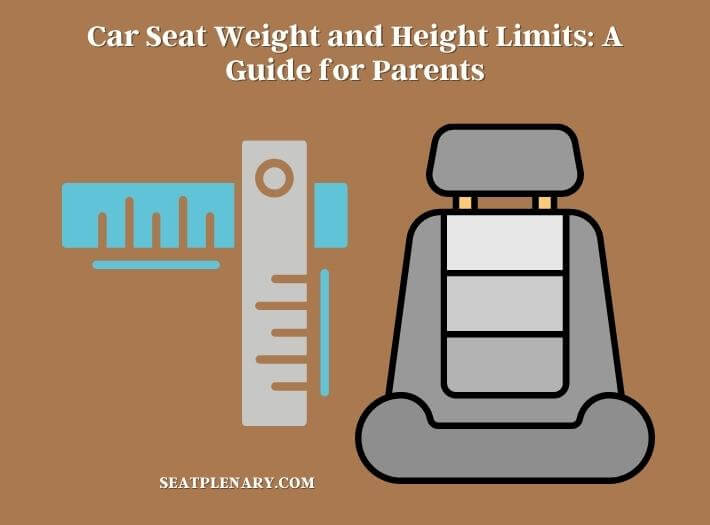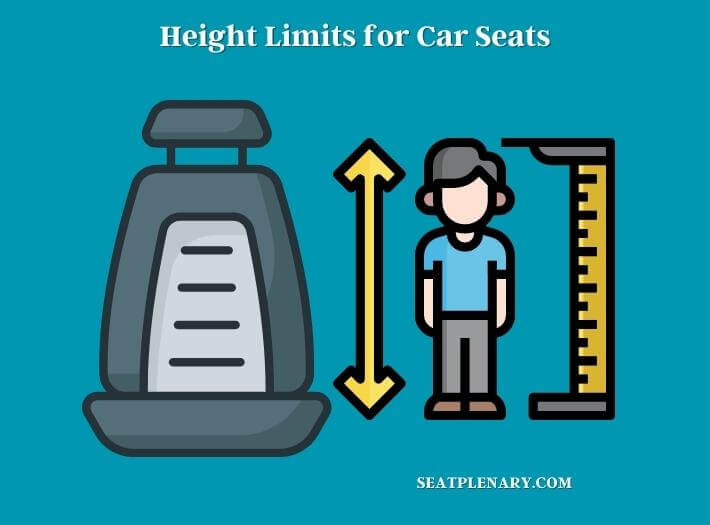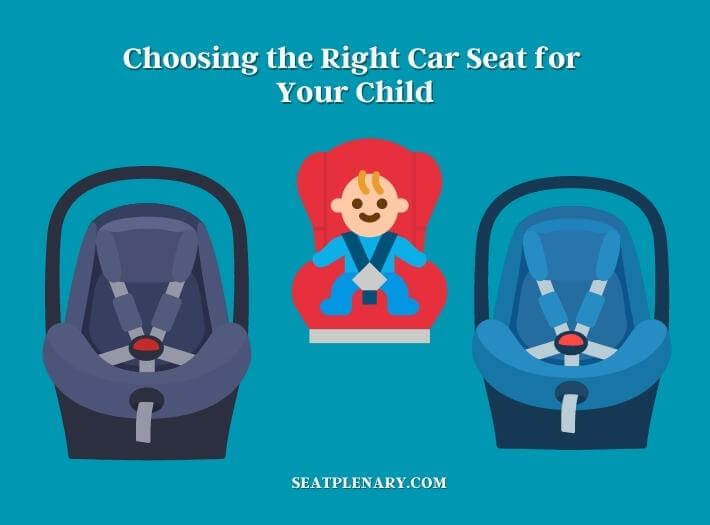Car seat safety is of utmost importance when it comes to protecting children while traveling in vehicles. In the United States, car accidents are one of the leading causes of death and injury among children. Many of these injuries and fatalities can be prevented by properly using car seats that meet the weight and height requirements of your child.

Car seat weight and height limits are crucial for ensuring that your child is adequately protected while traveling in a vehicle. Many parents are unaware of these limits and may inadvertently put their child at risk by using a car seat that is not suitable for their child’s weight and height.
Details About Types of Car Seats
There are several types of car seats available on the market, each designed for specific age groups, weights, and height ranges. Understanding the different types of car seats can help parents choose the right one for their child’s safety.
Infant Car Seats
These car seats are designed for newborns and infants up to 1-year-old or up to 22-35 pounds, depending on the model. Infant car seats are rear-facing and provide the necessary support and protection for a baby’s fragile neck, spine, and head.
Most infant car seats come with a detachable base that allows the car seat to be easily installed and removed from the car, making it convenient for parents to move their sleeping baby from the car to their home.
Convertible Car Seats
These car seats can be used both rear-facing and forward-facing and are suitable for older babies and toddlers. They typically have a weight limit of up to 40-50 pounds for rear-facing and up to 65-80 pounds for forward-facing, depending on the model. Convertible car seats are versatile and can be used for a longer period, making them a cost-effective option for parents.
Forward-facing Car Seats
These car seats are designed for older children and typically have a weight limit of up to 65 pounds. They are installed forward-facing and provide a 5-point harness system to secure your child. Forward-facing car seats provide more freedom of movement for the child, but it is recommended to use a rear-facing car seat for as long as possible to ensure maximum safety.
Booster Seats
Booster seats are designed for children who have outgrown forward-facing car seats but are not yet ready to use the vehicle’s seat belt without assistance. They typically have a weight limit of up to 120 pounds. Booster seats raise your child’s seating position so the vehicle’s seat belt fits properly over their chest and lap, providing them with the necessary support and protection.
Combination Car Seats
These car seats combine the functionality of a forward-facing car seat and a booster seat. They can be used with a 5-point harness system for younger children and converted into a booster seat when the child grows older. Combination car seats are suitable for children weighing up to 65-90 pounds, depending on the model.
It is important to note that the weight and height limits for car seats vary depending on the car seat manufacturer and model. Always check the car seat’s manual and follow the weight and height requirements to ensure your child’s safety.
Weight Limits for Car Seats
Weight limits for car seats are crucial for ensuring that your child is adequately protected while traveling in a vehicle. Different types of car seats have different weight limits, which can vary depending on the car seat’s design and purpose. Understanding these weight limits is important for choosing the right car seat for your child’s age, weight, and height.
Rear-facing car seats are designed for infants and young children. These car seats typically have a weight limit of up to 40 pounds for infant car seats and up to 65 pounds for convertible car seats. Infant car seats are designed to support newborns (it is not safe to feed a newborn in a car seat) and infants up to 1 year old, while convertible car seats can be used both rear-facing and forward-facing, making them suitable for older babies and toddlers.
Forward-facing car seats are designed for older children and have a weight limit of up to 65 pounds. These car seats are designed to be used once your child has outgrown their rear-facing car seat.
It is important to note that children should remain in a rear-facing car seat until they are at least two years old or until they reach the highest weight or height allowed by the car seat manufacturer, as recommended by the American Academy of Pediatrics.
Booster seats are designed for children who have outgrown forward-facing car seats but are not yet ready to use the vehicle’s seat belt without assistance. Booster seats typically have a weight limit of up to 120 pounds. These car seats raise your child’s seating position so that the vehicle’s seat belt fits properly over their chest and lap, providing them with the necessary support and protection.
Height Limits for Car Seats
Weight limits and height limits are other important considerations when choosing the right car seat for your child’s safety. A car seat’s height limit is determined by the distance between the top of the child’s head and the top of the car seat. It is important to ensure that your child fits within the car seat’s height limit to provide the necessary head and neck support and to prevent their head from protruding from the top of the car seat.

Rear-facing car seats typically have a height limit of up to 1 inch below the top of the car seat shell. It is important to ensure that the child’s head is at least 1 inch below the top of the car seat shell to provide the necessary head and neck support in the event of an accident. It is recommended to use a rear-facing car seat until your child reaches the maximum height or weight limit allowed by the car seat manufacturer.
Forward-facing car seats have a higher height limit than rear-facing car seats, usually up to the top of the car seat shell. It is important to ensure that your child’s shoulders are at or below the top harness slot to provide the necessary protection in the event of an accident. Once your child has outgrown the forward-facing car seat, it is time to transition to a booster seat.
Booster seats have a height limit of up to 57 inches or when the child can safely use the vehicle’s seat belt without assistance. It is important to ensure that the vehicle’s seat belt fits properly over your child’s chest and lap to provide the necessary support and protection.
Combination car seats have varying height limits depending on the manufacturer and model. It is important to check the car seat’s manual and follow the height and weight requirements to ensure your child’s safety.
Combination Car Seats
Combination car seats are a popular choice for parents who want to get more use out of their car seats. These car seats can be used as forward-facing car seats with a 5-point harness for younger children and then converted into booster seats for older children. Combination car seats typically have a weight limit of up to 65-90 pounds, depending on the model.
One of the advantages of a combination car seat is that it can be used for a longer period of time than a traditional forward-facing car seat. This can be a cost-effective option for parents who want to avoid purchasing a separate booster seat as their child grows older.
It is important to note that combination car seats are generally not suitable for younger babies and infants. They are designed for children who have outgrown their infant car seat and are ready to move on to a forward-facing car seat. It is recommended to use a rear-facing car seat for as long as possible to ensure maximum safety.
When using a combination car seat, it is important to follow the weight and height limits recommended by the car seat manufacturer. It is also important to ensure that the car seat is installed properly and that the harness straps fit snugly over your child’s shoulders and chest. The chest clip should be positioned at the armpit level to ensure that the harness straps are in the correct position.
As with any car seat, it is important to periodically check the combination car seat’s manual and ensure that it is still suitable for your child’s weight and height. If your child has outgrown the combination car seat, it is time to transition to a booster seat.
How to Choose the Right Car Seat for Your Child?
Choosing the right car seat for your child is an important decision that should not be taken lightly. The safety of your child while traveling in a vehicle is of utmost importance and selecting the appropriate car seat can provide the necessary protection in the event of an accident.

Age and Size
The first factor to consider is your child’s age and size. There are different car seats for different stages of development, including infant car seats, convertible car seats, combination car seats, and booster seats. Each type of car seat has its own weight and height limits, so it’s important to choose a car seat that is appropriate for your child’s age and size.
Type of Car
The type of car you have can also affect your choice of car seat. For example, if you have a small car, you may need a car seat that is more compact. If you have a car with a lot of legroom, you may have more options.
Ease of Use
It’s important to choose a car seat that is easy to install and use. Look for car seats that come with clear instructions and are easy to adjust. Some car seats may also come with features such as removable covers for easy cleaning.
Safety Features
When choosing a car seat, consider the safety features it offers. Look for car seats with features such as side-impact protection, a 5-point harness, and easy-to-adjust straps. Some car seats may also come with features such as an anti-rebound bar, which can provide additional protection in the event of an accident.
Brand and Price
Brand and price can also be factors to consider when choosing a car seat. Look for car seats from reputable brands that have a good safety track record. While it may be tempting to choose a cheaper car seat, remember that your child’s safety is the most important consideration.
Frequently Asked Questions
What is the Weight Limit for an Infant Car Seat?
Infant car seats typically have a weight limit of around 22-35 pounds, depending on the model. Once your child exceeds the weight limit, it’s time to transition to a convertible car seat.
What is the Weight Limit for a Convertible Car Seat?
Convertible car seats typically have a weight limit of up to 65 pounds, depending on the model. Once your child exceeds the weight limit, it’s time to transition to a combination car seat or booster seat.
What is the Height Limit for a Rear-facing Car Seat?
The height limit for a rear-facing car seat is typically around 1 inch below the top of the car seat shell. Once your child exceeds this height limit, it’s time to transition to a forward-facing car seat.
What is the Height Limit for a Forward-facing Car Seat?
The height limit for a forward-facing car seat is typically around 1 inch above the top of the car seat shell. Once your child exceeds this height limit, it’s time to transition to a booster seat.
Can I Use a Booster Seat for My Toddler?
Booster seats are designed for older children who have outgrown their forward-facing car seats. It is not recommended to use a booster seat for a toddler or young child.
Can I Use a Car Seat That Has Expired?
No, it is not safe to use a car seat that has expired. Car seats have an expiration date because the materials and safety features can degrade over time, which can compromise the effectiveness of the car seat in the event of an accident.
Can I Use a Car Seat That Has Been in a Car Accident?
No, it is not safe to use a car seat that has been in a car accident. Even if the car seat looks fine, there may be internal damage that can compromise its effectiveness in the event of another accident.
Bottom Line
Choosing the right car seat for your child is an important decision that can impact their safety while traveling in a vehicle. Understanding the weight and height limits for different types of car seats is essential in selecting the appropriate car seat for your child’s stage of development.
It’s important to consider your child’s age and size, the type of car you have, ease of use, safety features, and brand and price when choosing a car seat. It’s important to follow the manufacturer’s recommendations for weight and height limits and to avoid using car seats that have expired or been in a car accident.
Don’t hesitate to consult the car seat’s manual or contact the manufacturer for guidance if you have any questions about car seat weight and height limits. Remember, the safety of your child is the most important consideration.
